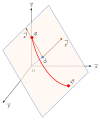Method for Calculating the Bending Angle of Puncture Needle in Preoperative Planning for Transjugular Intrahepatic Portal Systemic Shunt (TIPS)
- PMID: 29977326
- PMCID: PMC5998197
- DOI: 10.1155/2018/4534579
Method for Calculating the Bending Angle of Puncture Needle in Preoperative Planning for Transjugular Intrahepatic Portal Systemic Shunt (TIPS)
Abstract
Transjugular Intrahepatic Portal Systemic Shunt is a comprehensive interventional therapy for portal hypertension. During this intervention, puncturing from hepatic vein into portal vein is a difficult step. Selecting puncture needle with a proper bending angle is vital to accurate puncture. Thus, this prospective study provides a method to calculate the angle of the puncture needle using preinterventional contrast-enhanced CT imaging. According to the geometrical characteristics of puncture needle, Bezier curve equation was adopted to describe its bending part. By testing whether each point in a specific region satisfied the equation set of Bezier curves, the possible position of needle tip was obtained. Then, the bending angle of puncture needle was obtained by calculating curvature. The method was evaluated in 13 patients from 2 centers showing now a success rate of 100% and a duration of the procedure of 141 and 161 minutes. The method based on Bezier curve equation for calculating a proper bending angle of puncture needle was proven to be effective. And the clinical study is preliminary and additional work for clinical evaluation is necessary.
Figures





Similar articles
-
Investigation of bending angle algorithm and path planning for puncture needles in transjugular intrahepatic portosystemic shunt.Biomed Eng Online. 2025 May 27;24(1):66. doi: 10.1186/s12938-025-01397-2. Biomed Eng Online. 2025. PMID: 40426132 Free PMC article.
-
Contrast enhanced computed tomography and reconstruction of hepatic vascular system for transjugular intrahepatic portal systemic shunt puncture path planning.World J Gastroenterol. 2015 Aug 28;21(32):9623-9. doi: 10.3748/wjg.v21.i32.9623. World J Gastroenterol. 2015. PMID: 26327770 Free PMC article.
-
Transhepatic puncture of portal and hepatic veins for TIPS using a single-needle pass under sonographic guidance.AJR Am J Roentgenol. 2006 Jul;187(1):W87-91. doi: 10.2214/AJR.05.1342. AJR Am J Roentgenol. 2006. PMID: 16794144
-
Portal vein puncture-related complications during transjugular intrahepatic portosystemic shunt creation: Colapinto needle set vs Rösch-Uchida needle set.Radiol Med. 2021 Nov;126(11):1487-1495. doi: 10.1007/s11547-021-01404-1. Epub 2021 Aug 18. Radiol Med. 2021. PMID: 34405340 Review.
-
Novel Image Guidance Techniques for Portal Vein Targeting During Transjugular Intrahepatic Portosystemic Shunt Creation.Tech Vasc Interv Radiol. 2016 Mar;19(1):10-20. doi: 10.1053/j.tvir.2016.01.002. Epub 2016 Feb 2. Tech Vasc Interv Radiol. 2016. PMID: 26997085 Review.
Cited by
-
Comparison of Franseen and novel tricore needles for endoscopic ultrasound-guided fine-needle biopsy in a porcine liver model.Sci Rep. 2024 Sep 28;14(1):22453. doi: 10.1038/s41598-024-73184-3. Sci Rep. 2024. PMID: 39341878 Free PMC article.
-
Investigation of bending angle algorithm and path planning for puncture needles in transjugular intrahepatic portosystemic shunt.Biomed Eng Online. 2025 May 27;24(1):66. doi: 10.1186/s12938-025-01397-2. Biomed Eng Online. 2025. PMID: 40426132 Free PMC article.
References
-
- Cuijpers C. F. Tips for TIPS [D]; TU Delft, Delft University of Technology, 2015. - DOI
MeSH terms
LinkOut - more resources
Full Text Sources
Other Literature Sources
Medical
Molecular Biology Databases

